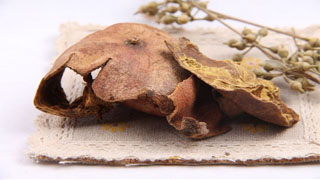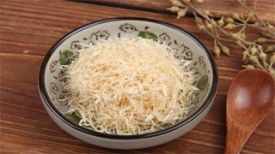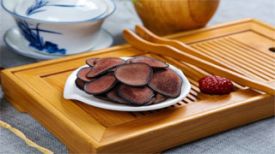
1. Alias
Pomegranate shells, pomegranates, and sour pomegranate peels.
2. Plant morphology
Deciduous shrubs or small trees. The bark is usually bluish gray or light yellow green, with longitudinal wrinkles and transverse pores; The young branches are nearly circular or slightly quadrilateral in shape, with a spike like tip and no hair. Leaves opposite or clustered, with short stalks; The leaves are rectangular lanceolate to rectangular elliptical in shape, with a gradually narrowing tip, entire margin, glossy on top, hairless, and raised main veins below. The flower stalk is solitary or several flowers that grow at the top of small branches or leaf axils, with large flowers; Calyx bell shaped, fleshy and thick, red, fused with ovary at the lower part, with 5-8 lobes at the top, triangular ovate lobes, and papillate protrusions on the outside, persistent; Petals are red in color and alternate with sepals in number. They are ovate in shape and gradually narrow at the base, with wrinkles. There are many stamens attached around the throat of the calyx tube. The anthers are light yellow, elliptical, and dorsal; Pistil 1, ovary lower or semi lower, upper 6-chambered, with lateral membranous placenta, lower 3-chamber, with central axis placenta, single style, sometimes 3 separated, stigma 2-3 lobed. Berries are nearly round in shape, with thick and leathery skin. When ripe, they are red or yellow with a reddish tint, and have persistent sepals at the top with thin septa inside. The seeds are mostly ovate, angular, with a red fleshy and juicy outer seed coat, and a leathery and hard inner seed coat. The flowering period is from May to June, and the fruiting period is from July to August.
3. Origin distribution
Born in fertile soil with good sunlight and drainage, it is a common cultivated tree species in gardens. Distributed in Fujian, Taiwan, Guangdong, Guangxi and other places.
4. Harvesting and processing
After the autumn fruits mature, collect the skin and air dry or sun dry them.
5. Characteristics of medicinal herbs
Irregular flakes or ladles of varying sizes. The outer surface is reddish brown, brownish yellow or dark brown, slightly glossy, rough, and has many wart like protrusions. Some have protruding cylindrical calyxes and thick short fruit stems or stem marks. The inner surface is yellow or reddish brown, with raised, reticular residue on the fruit stem. Hard and brittle in texture, with a yellow cross-section and a slightly granular appearance. Odorless, with a bitter taste.
6. Sexual Taste Returning to the Classics
Warm in nature, sour and astringent in taste. Returning to the colon meridian.
7. Effect and Function
Astringent intestines for stopping diarrhea, stopping bleeding, and deworming. Belonging to the subcategory of astringent drugs, it is a lung astringent intestinal medicine.
8. Clinical application
Dosage: 3-9 grams, decoct soup and take orally; Or into pills or powder. External use: appropriate amount, boil in water, smoke and wash, grind and sprinkle or apply. Used to treat chronic diarrhea, dysentery, rectal bleeding, prolapse, collapse, vaginal discharge, insect accumulation, abdominal pain, etc.
9. Pharmacological research
Treat diarrhea caused by imbalanced digestive function. Its decoction has antibacterial and antiviral effects in vitro experiments; Pomegranate peel alkaloid is the main effective ingredient for deworming, with the strongest killing effect on tapeworms, which can cause their muscles to contract persistently.
10. Chemical composition
Containing pomegranate peel bitterness, tannins, wax, mannitol, mucilage, gallic acid, malic acid, pectin, inulin, pomegranate peel alkaloid, isopomegranate peel alkaloid, etc.
11. Usage taboos
The dosage should not be too large. Caution should be exercised when taking medication for those with lingering dysentery.
12. Compatibility prescription
① The treatment of diarrhea is not limited to diarrhea and redness: sour pomegranate peel, burning nature, not much, dry as the powder. Hollow, adjust 6 grams of rice drink. (The Pocket Formula cites experience)
② Treating scald and fire injuries: Grind pomegranate peel into powder, mix with ice and sesame oil, and apply externally. (Selected Chinese Herbal Medicines from Shaanxi, Gansu, Ningxia, and Qinghai)
③ Treatment of anal prolapse: Pomegranate peel, aged clay, mixed with a little alum, fried and smoked, then fried and ground with gallnuts, and applied on top. (Compilation of Medical Banknotes)
④ Treating chilblains that have been rotten for a long time without healing: pomegranate peel, winter melon peel, and sugarcane peel are the three ingredients that burn ashes and retain their properties. Grind and apply. (Compendium of Materia Medica)
⊙ The content of the article is for clinical reference only. Non TCM professionals are not allowed to test drugs.


